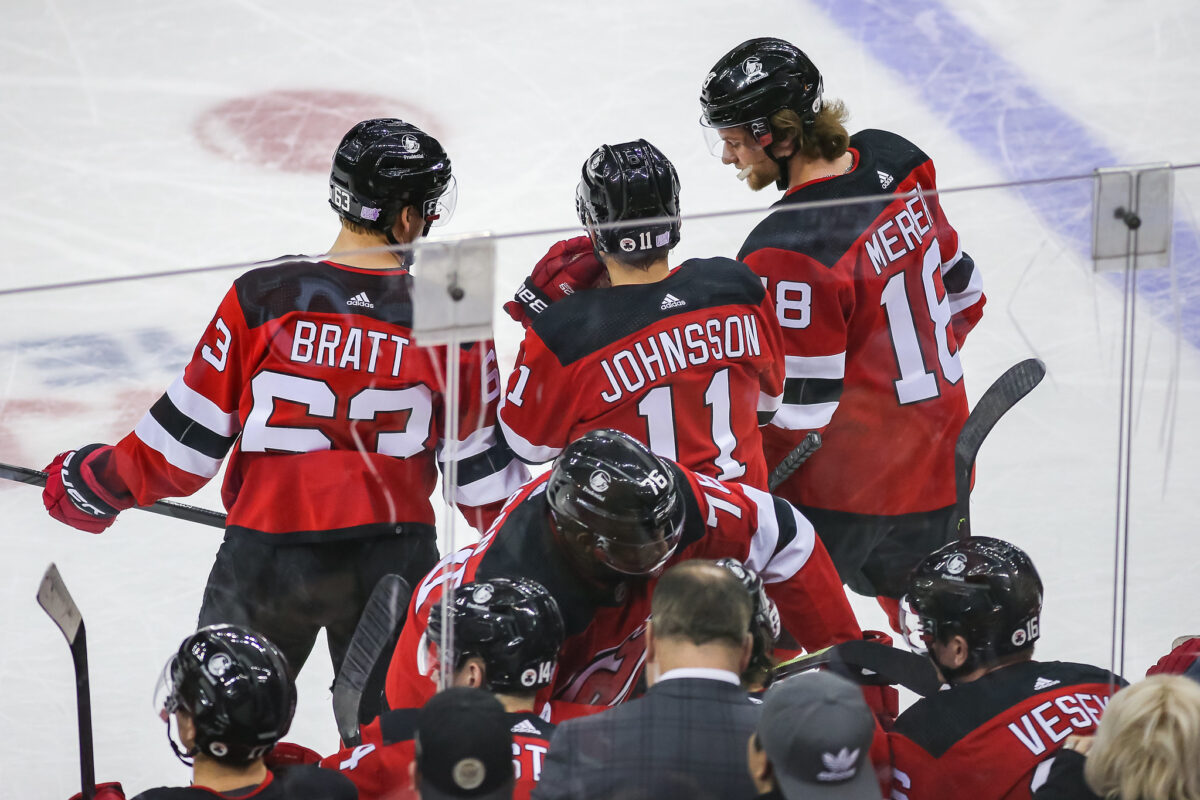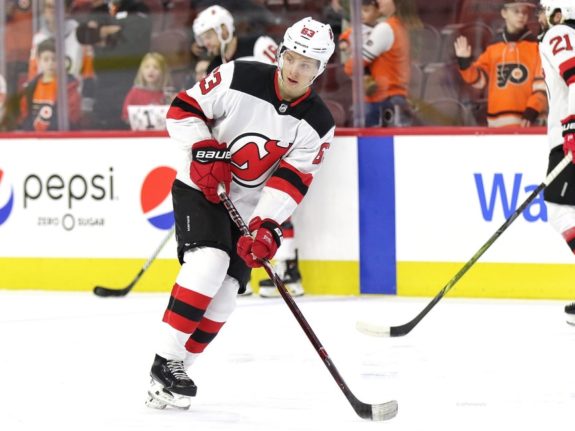Like Nico Hischier, the signs for a breakout season were always there for Jesper Bratt. That’s what the New Jersey Devils got from him this year, as he enters the final game of the 2021-22 season with 26 goals and 72 points in 75 games. It’s the first time the Devils had a 70-plus scorer since Taylor Hall in 2017-18, when he won the Hart Trophy as the NHL’s most valuable player.
Bratt will be a restricted free agent this offseason and is in line for a pretty significant pay raise from his $2.75 million cap hit. With not much having gone right for the Devils this season, he was one of the team’s lone bright spots. Let’s look back at his breakout season, why he’s now a building block, and what his next payday may look like this summer.
Bratt Emerged as Elite Scoring Winger
Bratt broke onto the scene as a rookie, along with Hischier, during the 2017-18 season when he scored 13 goals and 35 points in 74 games. In the three following seasons, he had shown flashes of being a top-six winger but hadn’t quite been able to match the production, averaging 49 points per 82 games.
However, Bratt started to show that a potential breakout was coming last season. He only totaled seven goals and 30 points in 46 games — a 53-point pace over 82 games. But it’s what he did at five-on-five that made the belief a breakout campaign was coming. He finished with a Corsi for percentage (CF%) of 53.49 percent and expected goals percentage (xG%) of 53.57 percent. He also averaged 1.88 points per 60 minutes, and this was with him only having three five-on-five goals.

His shot was a weakness, but he went to work with a shooting coach last offseason, and that seems to have paid off. Otherwise, everything else was there in Bratt’s game. The skating, the playmaking, the play-driving ability. It was all there. Add an above-average shot, and it’s a significant reason he was the Devils’ top scorer this season.
Bratt’s five-on-five numbers are the best he’s had in his young career as well. He leads the team in CF% at 53.97 percent and is second in xG% at 56.94 percent to Fabian Zetterlund (min. 100 minutes played) entering the final contest of 2021-22. Not only have the Devils carried play with him on the ice, but he’s been their most-efficient five-on-five scorer, averaging 2.88 points per 60.
Related: Devils’ Hischier Finally Had Breakout Season in 2021-22
Bratt’s five-on-five scoring rate is also one of the best in the NHL, ranking 19th among forwards with 100 minutes played. It puts him ahead of names like Mark Stone, Brad Marchand and Filip Forsberg. This isn’t to say Bratt is better than those wingers, but he scored at a rate among the NHL’s elite. Considering he turns 24 years old this summer, plenty of good hockey is still to come. Now comes the hard part and trying to figure out what his next contract may look like.
What Bratt’s Next Payday Could Be
The Devils and general manager Tom Fitzgerald will have to decide when negotiating a new contract with Bratt if the season he just had is repeatable. He was the team’s best player, but the catch is he’s never had a stretch producing at this level. So was it a fluke? Or is this sustainable?
There’s no fool-proof way to know, but one metric that helps predict whether future regression is coming is individual point percentage (IPP). What it does show is how often a player earns a point when his team scores and he’s on the ice. Over the previous two seasons, Bratt had IPPs of 69.44 and 75 percent. This season, it shot up to 83.05 percent, but it’s not the first time he’s gone over 80 percent; his IPP was 82.14 in 2018-19.
Those numbers may seem high, but elite-level players tend to have IPPs in the high 70s and low 80s. If we look at Bratt’s RAPM chart over the last three seasons, it shows a player who’s had a strong positive impact at even strength, specifically offensively, and one who’s a high-end play-driver that’d you expect to produce at the levels the NHL’s best forwards do:

Given all that, there shouldn’t be any significant regression in Bratt’s future. He might not be a 75-point scorer every season, but a drop back down into the low 50s seems unlikely. That means a payday is coming this summer. It’s hard to find a comparable for a former sixth-round pick that’s suddenly turned into a bonafide first-line winger. There’s Mark Stone, who was a sixth-round pick. But he didn’t get his big payday until he ended up on the Vegas Golden Knights after the Ottawa Senators traded him in the final year of his contract instead of losing him for nothing in free agency.
The easiest way to gauge what Bratt might get in a new deal is by looking at his teammates, Jack Hughes and Hischier. The Devils signed Hughes to an eight-year, $64 million extension earlier this season just after American Thanksgiving. He ended up going on a scoring tear, with 26 goals and 56 points in 49 games — a 43-goal, 94-point pace over 82 games. Even though Bratt ended up with 70-plus points, it’s hard to imagine Fitzgerald paying Bratt more than Hughes, who the Devils envision as the face of the franchise for the next decade.

Hischier may be a bit of a closer comparison. He’s missed the last few games with the flu but sits at 21 goals and 59 points in 69 games — a 25-goal, 70-point pace over 82 games. He earns $7.25 million a year for the next five years. I don’t see Bratt making as much as Hischier either, especially since Hischier is the team’s captain and plays a more important position in center. But it wouldn’t be a surprise if Bratt’s next contract comes somewhere a bit below Hischier’s in the $6.25 to $7 million range annually. That seems like fair value for where he is now and could even look like a steal when a big jump to the salary cap is expected in two to three years.
Bratt Is the Real Deal
Like Hischier’s breakout season, Bratt’s seems to be no fluke. For all the issues that the team’s had under coach Lindy Ruff, he’s done a great job turning the Devils’ forwards into game-breaking, offensive dynamos. Along with Hischier and Hughes, Bratt completes a trio that’s 23 years old or younger which the organization can build around for the next decade. There was some uncertainty whether Bratt was a core player for the Devils heading into 2021-22, but the answer is pretty clear now. He’s going to be around for the long haul.
* * *
Advanced stats from Natural Stat Trick, Evolving-Hockey
